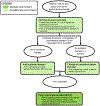2019 American College of Rheumatology/Arthritis Foundation Guideline for the Screening, Monitoring, and Treatment of Juvenile Idiopathic Arthritis-Associated Uveitis
- PMID: 31021511
- PMCID: PMC6788287
- DOI: 10.1002/art.40885
2019 American College of Rheumatology/Arthritis Foundation Guideline for the Screening, Monitoring, and Treatment of Juvenile Idiopathic Arthritis-Associated Uveitis
Abstract
Objective: To develop recommendations for the screening, monitoring, and treatment of uveitis in children with juvenile idiopathic arthritis (JIA).
Methods: Pediatric rheumatologists, ophthalmologists with expertise in uveitis, patient representatives, and methodologists generated key clinical questions to be addressed by this guideline. This was followed by a systematic literature review and rating of the available evidence according to the GRADE (Grading of Recommendations Assessment, Development and Evaluation) methodology. A group consensus process was used to compose the final recommendations and grade their strength as conditional or strong.
Results: Due to a lack of literature with good quality of evidence, recommendations were formulated on the basis of available evidence and a consensus expert opinion. Regular ophthalmic screening of children with JIA is recommended because of the risk of uveitis, and the frequency of screening should be based on individual risk factors. Regular ophthalmic monitoring of children with uveitis is recommended, and intervals should be based on ocular examination findings and treatment regimen. Ophthalmic monitoring recommendations were strong primarily because of concerns of vision-threatening complications of uveitis with infrequent monitoring. Topical glucocorticoids should be used as initial treatment to achieve control of inflammation. Methotrexate and the monoclonal antibody tumor necrosis factor inhibitors adalimumab and infliximab are recommended when systemic treatment is needed for the management of uveitis. The timely addition of nonbiologic and biologic drugs is recommended to maintain uveitis control in children who are at continued risk of vision loss.
Conclusion: This guideline provides direction for clinicians and patients/parents making decisions on the screening, monitoring, and management of children with JIA and uveitis, using GRADE methodology and informed by a consensus process with input from rheumatology and ophthalmology experts, current literature, and patient/parent preferences and values.
© 2019, American College of Rheumatology.
Conflict of interest statement
Figures



References
-
- Ravelli A, Martini A. Juvenile idiopathic arthritis. Lancet. 2007;369(9563):767–78. - PubMed
-
- Holland GN, Denove CS, Yu F. Chronic anterior uveitis in children: clinical characteristics and complications. Am J Ophthalmol. 2009;147(4):667–78 e5. - PubMed
-
- Tay-Kearney ML, Schwam BL, Lowder C, Dunn JP, Meisler DM, Vitale S, et al. Clinical features and associated systemic diseases of HLA-B27 uveitis. Am J Ophthalmol. 1996;121(1):47–56. - PubMed
-
- Rosenberg KD, Feuer WJ, Davis JL. Ocular complications of pediatric uveitis. Ophthalmology. 2004;111(12):2299–306. - PubMed
-
- Thorne JE, Woreta F, Kedhar SR, Dunn JP, Jabs DA. Juvenile idiopathic arthritis-associated uveitis: incidence of ocular complications and visual acuity loss. Am J Ophthalmol. 2007;143(5):840–6. - PubMed
Publication types
MeSH terms
Substances
Grants and funding
LinkOut - more resources
Full Text Sources
Medical

